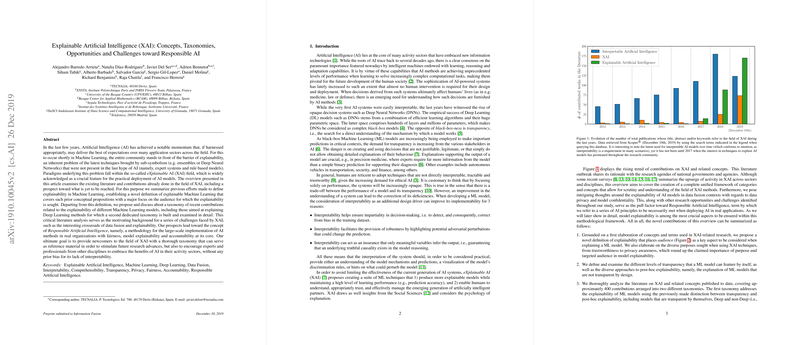Explainable Artificial Intelligence (XAI): Concepts, Taxonomies, Opportunities and Challenges toward Responsible AI
The paper "Explainable Artificial Intelligence (XAI): Concepts, Taxonomies, Opportunities and Challenges toward Responsible AI" provides an exhaustive overview of the state, methodologies, and challenges in the field of XAI. Authored by a prominent group of researchers, it scrutinizes recent literature to identify trends, strengths, and gaps related to XAI, stressing its salient role in implementing Responsible AI.
Summary of Content
The paper meticulously categorizes XAI methods into two main branches: transparent models and post-hoc explainability techniques. Each category is further dissected to clarify the levels of transparency defined as simulatability, decomposability, and algorithmic transparency for transparent models, while post-hoc techniques are categorized by their model-specific or model-agnostic nature, and further broken down into subclasses such as feature relevance, visualization, and model simplification.
Transparent Models
The discussion on transparent models underscores selections such as Linear/Logistic Regression, Decision Trees, K-Nearest Neighbors, Rule-based Learners, General Additive Models, and Bayesian Models. These models are characterized by their inherent interpretability based on their structural simplicity. For example, Decision Trees are simulatable due to their simple hierarchical structure and decomposable in terms of rule-based representation.
Post-hoc Explainability Techniques
The myriad post-hoc explainability techniques are divided into model-agnostic methods, which are applicable to any ML models, and model-specific methods tailored for particular types, such as deep neural networks or ensemble methods. For model-agnostic methods, approaches like Local Interpretable Model-agnostic Explanations (LIME) and SHapley Additive exPlanations (SHAP) are emphasized. Model-specific techniques include Layer-wise Relevance Propagation (LRP) and Guided Backpropagation for deep learners.
Theoretical and Practical Implications
The paper underscores a nuanced trade-off between model performance and interpretability. While increasingly complex models like deep neural networks exhibit superior performance, their black-box nature poses challenges for transparency. The authors call for a balance where advancements in XAI can mitigate the loss in interpretability without significantly compromising model performance.
The taxonomy presented aims to standardize the concepts and metrics necessary to evaluate XAI methods, advocating for a universal framework. This is crucial for effective comparisons and advancements in the field.
Deep Learning Specific Challenges
Given the prevalent use of deep learning (DL), the paper dedicates a detailed evaluation of DL-specific XAI methods. It classifies DL explainability techniques into subcategories like salience mapping, Layer-wise Relevance Propagation, and local/global explanation strategies such as deconvolution networks.
Opportunities in Data Fusion and Privacy
Interestingly, the paper explores the intersection of XAI with data fusion techniques – highlighting paradigms like Big Data Fusion and Federated Learning – showcasing how these techniques can preserve privacy and enhance explainability simultaneously. However, concerns regarding the possibility of XAI inadvertently breaching data privacy are also discussed, suggesting areas for further research and development.
Future Directions and Responsible AI
A significant portion of the paper is devoted to highlighting the importance of adhering to Responsible AI paradigms. It emphasizes fairness, transparency, and privacy, proposing that XAI should interleave these principles harmoniously. For instance, methods to ensure fairness, such as modeling techniques to mitigate bias introduced by protected attributes, are discussed alongside XAI methods like counterfactual reasoning.
The paper posits that the future of AI should integrate these principles seamlessly into development workflows while ensuring thorough assessment and governance to abide by ethical standards.
Conclusion
In conclusion, the paper "Explainable Artificial Intelligence (XAI): Concepts, Taxonomies, Opportunities and Challenges toward Responsible AI" positions itself as a pivotal reference in the XAI literature. It not only provides a comprehensive review of existing methodologies and trends but also poses critical insights into future research directions, emphasizing the need for standardized concepts and metrics. Furthermore, its consideration of XAI within the broader context of Responsible AI aligns with current ethical and societal expectations from artificial intelligence systems. This holistic approach ensures that AI advancements are both technically sound and ethically grounded, paving the way for more trustworthy AI practices.
